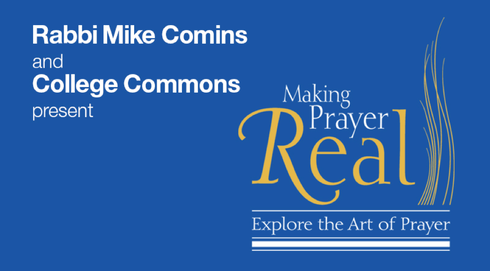MPR
|
Module 1: Engaging Prayer
|
|
Lesson Plans
1. The Difficulty of Prayer The MPR Course begins with a surprisingly honest evaluation of the obstacles to Jewish prayer. Students are moved by the discovery that clergy “get it.” 2. When Prayer "Works" and Mochin d'Gadlut This critical lesson outlines a “spiritual dynamics” approach to learning prayer and facilitates the students’ setting of goals for the MPR Course. 3. Yearning: Psalms and the Stirrings of the Heart In this session we explore the emotional sources of prayer. If gratitude is a response to what is, yearning expresses a desire for what isn’t. We explore the nuances of yearning, appreciate the artistry of the Psalms, and consider, “How can prayer help us to channel desire into holy desire?” 4. The Life of Gratitude Seeing the world as a cup “half full” is not a controversial idea. But the gap between knowledge and practice can be hard to bridge. In this session, we present the value and explore the means of cultivating a daily practice of gratitude. Videos
Conversations
|
Module 2: Foundations
|
|
Lesson Plans
5. The Art of Blessing We learn the basics of blessings, beginning with the baruch ata formula and the role of blessings in Jewish liturgy. Using our spiritual dynamics approach, we ask, “What is the purpose of praying a blessing?” 6. Prayer as a Practice Together with “When Prayer Works and Mochin d’Gadlut,” this session relates the MPR approach to learning prayer and deepening one’s prayer life. 7. Creating Sacred Space with Response Blessings Unbeknownst to many, the vast majority of traditional blessings are said after an event and unconnected to ritual. We consider the value of “response” blessings, and following Martin Buber, explore the role of blessings in creating sacred space. 8. Bringing Our Bodies into Prayer Reflecting on current knowledge of the mind/body connection and the role of music in synagogue services, we learn the advantages of consciously involving our bodies in prayer, and new ways to do it. Videos
Conversations
|
Module 3: Listening Deeply
|
|
Lesson Plans
9. Mindfulness: Listen Before You Speak A wise person listens before they speak, says the old adage, but rarely do daveners take the time to do so. Listening to our hearts and to the world around us—listening for God—is a skill that relatively few have devoted time to refining. We study mindfulness with leading teachers from the Institute for Jewish Spirituality, and we learn the basics of sacred, Hebrew chant with Rabbi Shefa Gold. 10. Tradition! The Benefits of Liturgical Prayer We apply our spiritual dynamics approach to liturgical prayer. How does communal, traditional prayer connect us to God and otherwise “work” in ways that other modalities do not? We learn how the MPR contributors work with liturgy through various interpretative techniques. 11. Shema 1: Liturgy as Sacred Story Exploring Joel Grishaver’s narrative approach to the Siddur, we consider the stories behind our tradition’s prayers, particularly the Shema, and how they affect our praying. We enter the Actor’s Studio to learn how we might be sacred actors in a sacred drama, speaking a holy script. 12. Shema 2: Understanding and Interpreting Liturgy Using simple literary techniques, we analyze the Shema and her blessings as a unit before considering the meanings of monotheism and the various intentions one might bring to praying the Shema. Videos
Conversations
|
Module 4: Personal Prayer
|
|
Lesson Plans
13. The Challenge of Personal Prayer Unscripted prayer raises obstacles, from simple unfamiliarity to the serious questions about theology that can no long be avoided when composing one’s own prayers. We explore the obstacles to personal prayer, and offer strategies to overcome them. 14. Cultivating Your Personal Prayer Voice Students learn several modalities to discover or deepen the experience of personal, unscripted prayer. 15. Teshuvah: Introspection for Change Throughout the MPR Course we have been exploring the effects of prayer. Now we zero in on what many consider the key question. How does prayer change us? We consider the characteristics of transformative prayer. 16. Discerning Divinity: Listening for a Response to Prayer The elephant in the room, the issue of God’s response to prayer, is often circumvented. The MPR contributors share their experience and their thinking. You might be surprised. Videos
Conversations
|
Module 5: Growing and Healing Through Prayer
|
|
Lesson Plans
17. Exploring the Amidah We learn and investigate the structure of the Amidah, focusing on the first three and the last three blessings in the rabbinic and mystical traditions. Then we discover our own interpretations. 18. The Amidah and Me After studying the weekday intermediate blessings and learning the historical background, we return to the way people prayed in Talmudic times. Ending each blessing with the traditional formula, students create a personal Amidah. 19. Coping with Illness and Loss Does prayer heal? The MPR contributors speak from the heart. We explore prayer practices for healing. 20. Mourning and Kaddish Rabbi Anne Brener explores the nuances of grief, and how prayer might catalyze the mourning process. The MPR contributors speak about Kaddish and mourning. Videos
Conversations
|
